
What to Choose: In-house Software Development vs Outsourcing
Summarize:
Over the last decade, the outsourcing market has changed dramatically. Some historically common cons and pros of outsourcing are already largely irrelevant, though they may still be persuasive enough for many organizations to hire an in-house team. However, in 2021, companies started opting for outsourcing more frequently than before the COVID-19 pandemic, and this tendency continues even in 2023.
Experienced professionals for software development and augmentation
Get software experts solely focused on your project with the required level of proficiency and seniority
Contact usIT outsourcing gaining momentum
Among the keen supporters of outsourcing are such giants as Nike, Google, IBM, American Express, HSBC, KPMG, and Toyota Tsusho. The last two companies, by the way, are Yalantis clients with whom we have long-term partnerships.
The UK financial services company HSBC currently outsources IT operations to service providers in up to 14 countries, including their home country of the UK and even the USA. A 154 percent increase in the number of customers using the HSBC mobile app between July and September 2020 inspired HSBC’s management team to continue their digital journey.
Among many outsourcing projects, HSBC is now working on advanced analytics initiatives and robotic process automation (RPA) solutions, and they are planning to enhance the latter with artificial intelligence (AI) and machine learning (ML) capabilities.
Small and midsize businesses (SMBs) can also benefit from software outsourcing, as 2021 proved to them the importance of rapid digitalization. A 2021 survey by Harris Poll on behalf of Salesforce of 2,534 SMB leaders worldwide revealed that more than half of SMBs accelerated their investments in new technologies in 2021.
Read further if you aren’t sure whether outsourcing is worth it and want to make the right choice. In this blog post, we’ll show you the real and unbiased side of in-house development vs outsourcing. First, let’s have a look at the challenges you may face if you opt for hiring a software development team in-house.
Four challenges of in-house software development vs outsourcing
In-house development obviously has its bright sides, like deep team involvement in the development process and possibly better culture and communication fit as compared to outsourcing. However, recent events have changed the picture, and now hiring an in-house development team may be more challenging than in pre-pandemic times. Below are four of the most impactful challenges that complicate the process of hiring in-house IT teams.
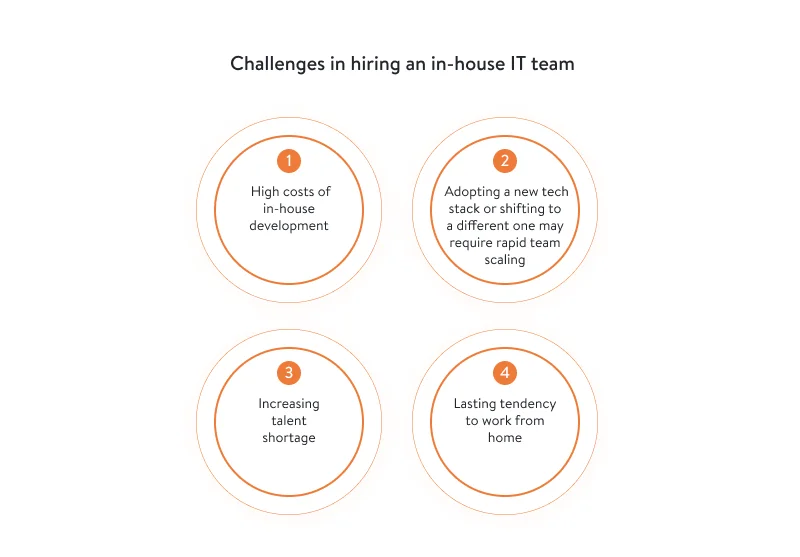
Challenge #1. High costs of in-house vs outsourcing development
The high cost of in-house developers is an obvious challenge, but it’s also one of the most impactful. According to the 2022 Global Software Outsourcing Trends and Rates Guide by Accelerance, the total cost of working with the average internal team is almost two times higher than the cost for an average outsourcing team. Apart from salaries, the total cost of working with in-house employees includes:
- Personnel maintenance (sick leaves, vacations)
- Workspace maintenance
- Additional support from the HR department, recruiters, managers, etc.

According to Indeed, software developers in the US earn an average of $116,182 per year (the average across entry-level to senior-level positions). And only 63 percent of 3,140 respondents to Indeed’s survey on salary satisfaction rate were satisfied with their salaries. Therefore, it might be not only difficult to hire skilled software engineers in the US but also to ensure they’re satisfied with the salaries you can offer.
When signing a contract with a mature outsourcing software agency, you can save money and still get quality services. Learn how to staff your software project in conditions of the overheated IT outsourcing market.
Challenge #2. Adopting a new tech stack or shifting to a different one may require rapid team scaling
According to Gartner’s 2021 CIO Survey, 69 percent of respondents (1,877 CIOs across different industries) are accelerating digital business as a result of COVID-19. Another global survey by McKinsey reveals that 64 percent of respondents (1,140 C-level executives across diverse industries) are planning to develop a completely new digital business model by 2023 to meet the demands of the rapidly evolving technology world. In keeping up with the pace of digital transformation, organizations may bump up against their inability to scale in-house IT teams.
Another case when a team may need to rapidly scale is when a company needs to quickly shift a project from one tech stack to another. In such a situation, firing or retraining existing employees can be just as expensive and time-consuming as recruiting new ones. Plus, product companies often lack a clear recruitment strategy to scale quickly.
The limited technical expertise of in-house teams may also hinder timely digital acceleration. That’s when outsourcing teams can come to the rescue, as rapid team scaling is one of the benefits of outsourcing.
Read also: Digital transformation roadmap of your supply chain business: preparation tips
Challenge #3. Increasing talent shortage
The gap between the demand and supply of IT specialists is only going to increase in the years to come. According to CNBC’s Technology Executive Council 2021 survey, the labor shortage has become the biggest concern for technology executives worldwide in beating cybersecurity threats. A 2021 survey by Gartner reveals that a talent shortage is also the biggest barrier for businesses on the way to adopting emerging technologies. A rapidly evolving outsourcing market with a wide talent pool can save the day for the global IT community and bridge the gap between IT talent supply and demand.
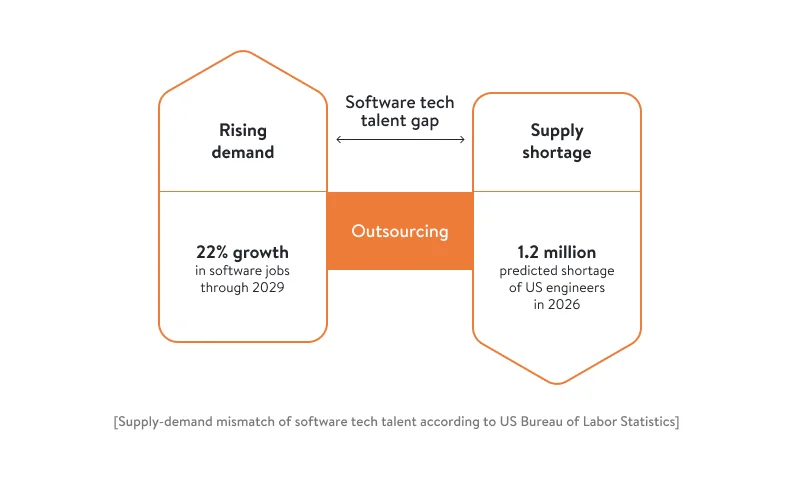
Korn Ferry suggests that the issue with the talent gap is only going to intensify in 2022, requiring organizations to come up with more elaborate employee hiring and retention strategies. And even if you aren’t seeing any signs of a tech talent shortage within your particular organization, it could still be an issue for you in the years to come.
Challenge #4. Lasting tendency to work from home
Working from home became popular during the COVID-19 pandemic. Even though many companies are now coming back to the office, many employees have gotten used to working from home and don’t want to change their new way of life. According to GoodHire, 85 percent of Americans are more likely to apply to jobs that offer remote or hybrid work opportunities. Telework destroys one of the main pros of hiring insourcing, which is the possibility to monitor employees and have more control over them.
The global tendency to work remotely blurs the line between in-house and outsourcing, as you can now hire a remote software outsourcing team and spend less money than on maintaining a remote in-house team. Logically, many organizations are now more driven to outsource than before.
With the tech world expanding so quickly, we believe that currently, it’s much more beneficial to work with outsourcing partners rather than hire IT specialists in-house. While spending much time on the bureaucracy of hiring in-house, you limit yourself to a narrow pool of specialists who are not necessarily qualified for the salaries they request.
Now, let’s consider concerns that might keep you from looking for a reliable IT service partner.
Tackling common misconceptions about ITO services
Let’s have a look at commonly accepted disadvantages of outsourcing software development that are no longer relevant. We realize that outsourcing companies differ in their size and the quality of delivered services, and for some IT providers these disadvantages may actually exist. However, we are concentrating in this post on mature and trustworthy software partners, for whom the following concerns no longer apply.
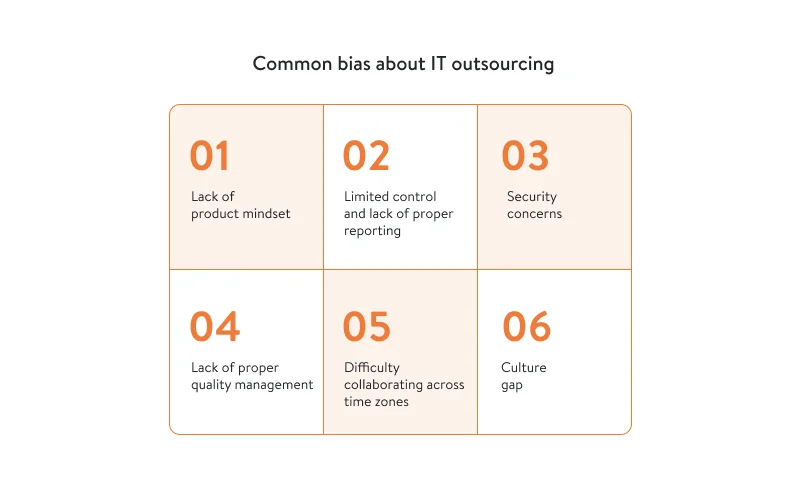
#1. Lack of product mindset
Often, clients perceive outsourcing as a way of allocating software projects to a team of developers not expecting from them anything but simple execution. Some outsourcing companies work this way, but the overall tendency in the outsourcing industry is to provide clients with all-around technology and business solutions.
This means a shift from a project to a product mindset. Progressive outsourcing companies are now offering dedicated teams who proactively collaborate with clients and provide constant feedback on improving their products.
Technology specialists in the top-performing outsourcing companies are becoming business-savvy and industry-focused to also serve as business consultants. For instance, Yalantis software architects offer our clients architecture design according to their needs. And even in situations when tech-savvy clients come with a solid belief that they need, for example, a monolithic architecture, our architects may not agree and may offer a more fitting design like a microservices architecture.
You can explore more of Yalantis’ expertise, by reading our article about digital banking architecture.
This shift from technical to product ownership can make collaboration with an outsourcing website development or app development teams feel like collaboration with an in-house team. Such a shift lends itself to allocating teams to distinct features of the product rather than separate technologies or platforms.
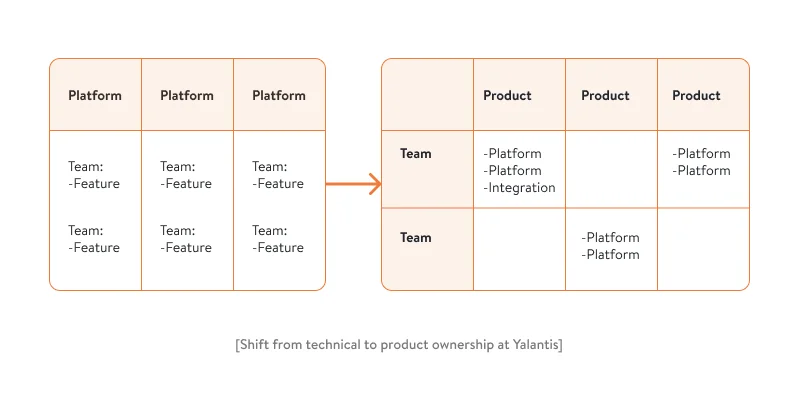
#2. Limited control and lack of proper reporting
Today, with a growing number of remote teams, you may not even see the difference between an in-house IT department and an outsourced one. If you prioritize control and reporting, you can engage in your project to the greatest possible extent. But such a high level of control is necessary only at the first stages of your cooperation with a new outsourcing partner. As your trust builds over time, you can allow yourself to loosen the grip and even rely on your IT service partner for tasks that require much more responsibility.
Most outsourcing companies provide their clients with a whole team to work on the project, including a project manager (PM). You may request your PM to create a presentation outlining the whole development process so you can decide to what extent you want to be involved in the project. A company that wants to become your dedicated and long-term software partner will take all your requests into consideration.
Read also: What a project manager does at each stage of the software development process
#3. Security concerns
Some IT service companies fail to provide clients with convincing evidence of their security practices and thus create a lack of trust in the whole outsourcing industry. Reliable outsourcing companies acknowledge the necessity of providing clients with a detailed explanation of their security measures.
A reputable outsourcing service provider must have a clear security policy that ensures all employees are on the same page. Given each project’s specifics regarding compliance requirements, a security policy helps technical specialists make sure they comply with all security requirements during project execution.
The presence of a Chief Information Security Officer (CISO) and a security department in an IT service company can also be a good sign of a trustworthy software partner with whom it’s safe to sign a contract. In one more of our blog articles, you can find out about technologies we use at Yalantis to ensure a high level of security on our projects.
#4. Lack of proper quality management
Another common misconception regarding outsourcing software development is that your project will lack proper quality management. However, mature software development partners establish a solid approach to managing quality. You can look for outsourcing partners with Centers of Excellence and a Software Development Office, as such entities are responsible for spreading and accumulating unified approaches to software development and quality management within a software company.
Plus, a modern approach to project management suggests a shift from focusing merely on budget and time constraints to focusing more on the quality and visibility of the development process.
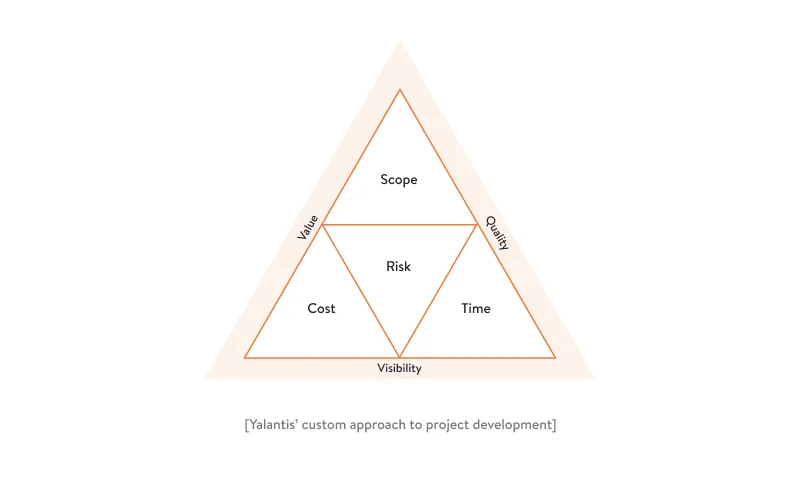
#5. Difficulty collaborating across time zones
This issue you can handle by deciding to work with a nearshore rather than an offshore partner. However, even with an offshore partner you will probably still have a few overlapping hours to discuss important matters. Both nearshore and offshore outsourcing partners may ensure round-the-clock project development. While you focus on your core business during the day, your outsourced IT department can back you up when you’re sleeping.
Time zone differences shouldn’t be a significant roadblock on your way towards building a close partnership with an overseas partner. But in case you have doubts, you can contact an IT company’s previous clients to hear firsthand how the company handled time zone differences.
#6. Communication and culture gap
Some countries may have significant communication and cultural differences compared to others. At Yalantis, our European and US clients commonly tell us that we share lots of common values with them and have strong English skills. In fact, Ukraine took 40th place out of 112 countries in English proficiency in 2021, compared to 49th place in 2019.
The outsourcing market is constantly changing, improving, and adjusting to current business needs. That’s why when beginning your search for an outsourcing partner, you shouldn’t start by thinking “I want a cost-effective solution, which is why I’ll go for outsourcing and agree on lots of tradeoffs.” Start with an open and unbiased mind. Even if you can’t have it all with outsourcing, you still can find a qualified partner to meet most needs that you thought only an in-house IT team could meet.
Tips on how to build a trusting and productive partnership with your outsourcing team
Once you find a suitable software outsourcing partner, you can work on building a trusting, long-term relationship with your ITO team. A long-term relationship, by the way, doesn’t mean that once your project is over, you continue paying your development team. It means that you can always return to your trusted software partner with a new project or simply for support with your already developed product.
We’ve compiled a shortlist of actions you can take to ensure a trusting and fruitful relationship with IT service partners:
- Facilitate deep team involvement in the project. Consider preparing presentations and town hall meetings about your company and the product’s role in achieving your company’s goals and mission. Such meetings help the team develop a stronger bond with your product and reach project goals on time.
- Show initiative and learn about your team. If you pay enough attention to your team, their level of involvement will increase. Remember to express your genuine appreciation for team members’ jobs and regularly provide fair feedback.
- Participate in daily meetings and other project-related events. You decide to what extent to be involved in your project. However, if a client often misses essential meetings, they may lose track of the project’s evolution and miss the opportunity to make timely changes.
To reduce the level of anxiety when investing in a partnership with a new IT partner, you can start with developing an MVP or a pilot project. When doing so, you can check your partner’s credibility without huge risks.
And remember that not only your outsourcing partner takes responsibility for the quality of the delivered project; you also do, as the business owner. Proactive two-sided collaboration between a client and their outsourcing team is the cornerstone of a quality end product.
What makes Yalantis a reliable software partner?
Yalantis has been in the IT outsourcing market for 14 years and has evolved tremendously over this time. In this section, we aren’t going to brag about our achievements but rather share a few facts:
- Most of our clients stay with us for more than five years.
- On average, our employees stay with us for more than three years.
- We work on approximately 45 projects annually.
- Our team also provides IT consulting services to help on your digital transformation journey.
- At Yalantis, we don’t overwhelm you with technical terms but rather clearly explain how we can solve your challenges using which technologies and why.
- Your security is our priority. That’s why we have established a bullet-proof cybersecurity department and deeply investigate each project with regard to all compliance requirements.
- We’re constantly adopting cutting-edge technology innovations and trends to ensure you won’t get a solution that would have been relevant three or five years ago.
- Our domain-focused teams dive deep into your needs to deliver industry-specific solutions that increase your competitiveness and help you perform better than your rivals.
Explore our Expertise, Services, and Works pages to see for yourself. We’re always open to discussing your specific business case, as providing cookie-cutter solutions and services isn’t our way of working. Let’s get to know each other to find a solution that can satisfy you and surpass your expectations.
Rate this article
3.1/5.0
based on 27 reviews





